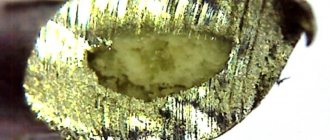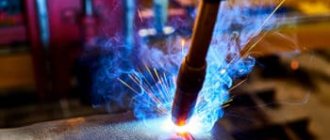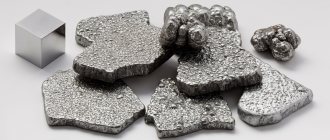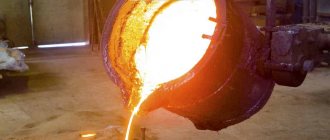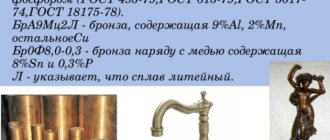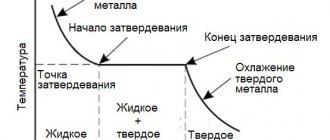Melting point and other properties of tin and lead based solders
The table shows the melting point of solders of common brands based on tin and lead, as well as their thermophysical and mechanical properties.
The properties of solders are given at room temperature. The table shows the following properties: melting point of solders (solidus and liquidus) in degrees Celsius, solder density, electrical resistivity, thermal conductivity, tensile strength, elongation, impact strength, Brinell hardness, HB.
The melting point of solders (liquidus - the liquid state of solder) based on lead and tin is in the range from 145 to 308 ° C. It should be noted that the melting temperature of the solder, equal to 145°C, corresponds to POSK 50-18 solder, which belongs to the category of low-melting solders. At a temperature of 308 degrees Celsius, POSSu 5-1 solder is in liquid form.
The properties of the following solders are considered: POS 90, POS 61, POS 40, POS 10, POS 61M, POSK 50-18, POSSU61-0.5, POSSU 50-0.5, POSSU 40-0.5, POSSU 35-0, 5, POSSU 30-0.5, POSSU 25-0.5, POSSU 18-0.5, POSSU 95-5, POSSU 40-2, POSSU 35-2, POSSU 30-2, POSSU 25-2, POSSU 18 -2, POSSU 15-2, POSSU 10-2, POSSU 8-3, POSSU 5-1, POSSU 4-6.
According to the table, it can be seen that the density of solders varies from 7300 to 11200 kg/m3 . The solder with the minimum density is tin-lead solder POSu 95-5. The heaviest of the solders considered is POSSu 5-1 solder - the density of such solder is 11200 kg/m3.
The thermal conductivity of solders in the table is given in kcal/(cm·s·deg). Solders with maximum thermal conductivity are POS 90 and POSK 50-18 - their thermal conductivity is 0.13 kcal/(cm s deg).
Flux for soldering with a soldering iron
Flux is an auxiliary substance necessary for freeing the surfaces of parts being soldered from oxides and for better spreading of solder over the metal surface during soldering. Without using flux, it is almost impossible to perform high-quality soldering with a soldering iron.
When preparing the most popular fluxes for soldering with an electric soldering iron, rosin is used. It is obtained from the wood of coniferous trees, mainly pine. At a temperature of about 50°C, rosin softens, and at 250°C it begins to boil.
Rosin is not resistant to atmospheric moisture - it hydrolyzes. It consists of 85-90% abietic acid. If you do not remove the remaining rosin after soldering, oxidation of the soldering area occurs. Many people do not know this and believe that rosin is harmless to metal. In addition, by absorbing water from the atmosphere, rosin increases its conductivity and can disrupt the operation of electronic devices, especially their high-voltage circuits.
Popular fluxes for soldering with an electric soldering iron
| Flux name | Composition % of total volume | Application area of flux | Method for preparing flux | Removing flux residues |
| Rosin inactive fluxes | ||||
| Light rosin | Light rosin – 100 | Soldering of copper and its alloys with low-melting solders | Ready to use | Alcohol or acetone, brush |
| Alcohol-rosin | Rosin - 20 Alcohol - 80 | Soldering of copper and its alloys with low-melting solders in hard-to-reach places | Dissolve rosin powder in ethyl alcohol | |
| Glycerin-rosin | Rosin - 6 Glycerin -14 Alcohol - 80 | Sealed soldering of copper and its alloys with low-melting solders in hard-to-reach places | Dissolve rosin powder in ethyl alcohol, then add glycerin | |
| Rosin active fluxes | ||||
| Rosin zinc chloride | Rosin - 24 Zinc chloride - 1 Alcohol - 75 | Soldering of non-ferrous and precious metals, critical parts made of ferrous metals | Dissolve mixed powders of rosin and zinc chloride in ethyl alcohol. | Acetone, brush |
| Rosin zinc chloride (flux paste) | Rosin - 16 Zinc chloride - 4 Vaseline - 80 | High-strength soldering of non-ferrous and precious metals, critical parts made of ferrous metals | Mix rosin and zinc chloride powders with technical petroleum jelly | |
| Acidic active fluxes. | ||||
| Zinc chloride | Zinc chloride - 25 Hydrochloric acid - 1 Water - 75 | Soldering of parts made of ferrous and non-ferrous metals | The acid is slowly poured into the dish up to ¾ of its height with pieces of zinc, when the hydrogen bubbles stop emitting, the flux is ready | Washing with water or a solution of baking soda in water, with a brush |
| Rosin - 16 Zinc chloride - 4 Vaseline - 80 | Flux paste. High-strength soldering of non-ferrous and precious metals, critical parts made of ferrous metals | Mix rosin and zinc chloride powders with technical petroleum jelly | ||
| Rosin - 24 Zinc chloride - 1 Alcohol - 75 | Soldering of non-ferrous and precious metals, critical parts made of ferrous metals | Dissolve mixed powders of rosin and zinc chloride in ethyl alcohol. | ||
| FIM | Orthophosphoric acid (density 1.7) - 16 Ethyl spirit - 1.6 Water - the rest | Soldering of copper, silver, constantan, platinum, stainless steel, ferrous and other metals | The acid is slowly poured into the container and then alcohol is added | Washing with water, brush |
Flux based on alcohol and solvents must be stored in an airtight container, otherwise the liquid will quickly evaporate. A bottle of manicure polish is very convenient for this purpose. Always have a brush at hand, which is convenient for applying flux to the soldering area. You can find such a bottle in almost any home. Another advantage is that the brush and twist are not dissolved by alcohol and solvent. Before filling with flux, be sure to thoroughly wash the bottle and varnish brush. If the varnish has hardened too much, pour in acetone and leave. After a while the varnish will dissolve.
I prepare alcohol-rosin flux in a bottle. First, I pour rosin powder through a paper funnel and then fill it with alcohol. It is easy to pour alcohol into the narrow neck of the bottle if you touch the neck of the bottle with alcohol to a brush previously soaked in alcohol. You need to pour it very slowly and you won’t spill a single drop. Over time, the alcohol evaporates and the flux becomes thick. Then you need to dilute it with alcohol to the required consistency.
As a flux, I often use the undocumented flux of aspirin (acetyl salicylic acid), which is used as a medicine. With its help, you can tin copper and steel surfaces without prior preparation. Liquid flux for soldering with a soldering iron can easily be prepared on the basis of aspirin; just dissolve the tablet in a small amount of alcohol, acetone or water.
Melting temperature of solders and low-melting alloys
The table shows the melting temperatures of solders and low-melting alloys based on mercury Hg, cesium Cs, potassium K, bismuth Bi, thallium Tl, indium In, tin Sn, lead Pb, cadmium Cd, Wood's alloy, Rose alloys, gold Au , magnesium Mg, zinc Zn, silver Ag.
The melting temperatures of solders and alloys in the table are given starting with the most fusible alloys and range from -48.2 to 262°C. In alloys with a negative melting point (from minus 48.2°C), the content of mercury and alkali metals predominates. Low-melting alloys with a melting point from 200 to 260°C have a predominant content of bismuth and thallium in their composition.
Note: eut - eutectic alloys or close to them; For non-eutectic alloys, solidus temperatures are given.
Solder Material Selection
One of the main criteria for choosing an alloy for creating a solder joint of metal parts is its melting point.
That is, the filler material must melt earlier than the base material. But this is not the only condition for choice.
The liquid melt should well wet the surface of the base metal. In addition, certain strength requirements are imposed on the soldered joint.
The correct selection of filler material for soldering allows you to bring the strength of the connection closer to the strength of the base metal.
It is for this reason that when soldering any metal product, they try to use an additive based on the same metal as the metal of the product.
At the same time, the lower melting temperature of the solder is ensured by the additional components included in its composition.
However, it should be noted that it is never possible to equalize these characteristics when soldering. That is, during mechanical fracture tests, fracture will always occur at the joint.
In some specific types of soldering, the strength of the connection does not play a major role. For example, when soldering jewelry, the main thing is the aesthetic part of the work. Therefore, products made of gold, silver and platinum are soldered only with solders based on the same metals, and of the same standard.
Density of solders and babbits, their thermal conductivity and thermal conductivity
The tables give the thermophysical properties of some solders and babbitts (anti-friction bearing materials) at room temperature. Properties such as density, coefficient of thermal expansion and thermal conductivity are presented.
The properties of the following solders and babbitts are indicated: POS-30, POS-18, PSr45, POTs70, POTs60, 34A, eutectic silumin; babbits, B83, B16, BKA, B88, B89, B6.
It should be noted that the density of solders, coefficient of thermal expansion (CTEL) and thermal conductivity of solders and babbitts have similar values, with the exception of solder 34A and eutectic silumin, which are 2-4 times lighter.
Requirements
In order to heat metal bends, you will need to use special equipment called a soldering hair dryer. According to the requirements, the soldering device must be heated to a certain temperature of up to 800 degrees. Some models have a controller, which makes using the device much easier. Soldering stations with a hot air gun are also available on sale. They come in turbine and compressor types. Despite the design and cost of the device, it must be made of high-quality heat-resistant material.
Composition and thermal conductivity of solders and babbitts at different temperatures
The table shows the composition and value of the thermal conductivity coefficient of aluminum antifriction alloys, babbitts and solders at temperatures from 4 to 300 K (from -269 to 27 ° C).
The following solders and bearing materials were considered: AN2.5, AO6-1, BKA, B16, B83, B88, POS61, POS18, POSSu18-2, POSSu40-2, Wood's alloy, Rose's alloy, PSr25, PSr44, PSr70.
The most thermally conductive antifriction alloy, according to the table, is the AO6-1 alloy - its thermal conductivity is 180 W/(m deg). Silver solder PSr70 (based on silver and copper) has the highest thermal conductivity among the considered solders - the thermal conductivity of this solder is 170 W/(m deg).
Sources:
- Physical quantities. Directory. A.P. Babichev, N.A. Babushkina, A.M. Bratkovsky and others; Ed. I.S. Grigorieva, E.Z. Meilikhova. - M.: Energoatomizdat, 1991. - 1232 p.
- Chirkin V.S. Thermophysical properties of nuclear technology materials.
- Tables of physical quantities. Directory. Ed. acad. I.K. Kikoina. M.: Atomizdat, 1976. - 1008 p.
- Non-ferrous metals. Directory. - Nizhny Novgorod: "Venta-2", 2001. - 279 p.
Solder pastes (tinol) for soldering
Solder paste (tinol) is a composition of solder and flux. The paste is irreplaceable when soldering with a soldering iron in hard-to-reach places, and when installing unframed radio components. The paste is applied with a spatula in the required amount to the soldering area and then heated with an electric soldering iron. The result is a beautiful and high-quality soldering. Its use is especially convenient if you have no experience working with a soldering iron.
You can make your own pasta. To do this, you need to select a brand of solder suitable for soldering the required metal. Next, use a file with a large notch to cut sawdust from the rod. Then add the liquid soldering flux selected from the table, mixing the sawdust until a paste-like composition is obtained. The paste should be stored in an airtight container. The shelf life of the paste is no more than six months, since solder filings oxidize over time.
Technology
The process of performing the work consists of 3 main parts: desoldering the old element, cleaning the board from excess solder and installing the new part. Let's consider these stages separately.
Dismantling the old component is carried out in a certain sequence.
Important! You need to lift the old part straight up, preventing it from moving to the sides. Otherwise, the melted solder will short-circuit adjacent contacts and will not be easy to remove.
Or even worse, a track will come off the board, which will be even more difficult to restore.
Next, we move on to preparing the contact pads of the board.
- Melt the solder at the contact point.
- If you have a syringe, use it to remove excess metal.
- If you don't have a syringe, use copper braid. To do this, fluff it minimally so that the pores are visible. Next, coat it liberally with flux, apply it to the joint and heat it with a hairdryer or soldering iron. The braid will absorb excess metal. After this, it remains to cut off the unnecessary part.
The board should be completely free of solder.
Next we move on to preparing the part. The main task is to apply solder to the contacts in the form of balls of the same size (this is called reballing). To do this, use a stencil.
A stencil is a metal plate with many holes into which a part is inserted using legs.
To use it, do the following.
- secure the radio component to the stencil with special electrical tape;
- Apply solder paste on the back side with a spatula;
- set the heating temperature to 300 degrees;
- heat the part together with the stencil, and when the characteristic shine appears, turn off the heating;
- Allow the component to cool completely;
- remove the electrical tape;
- turn on the heat to 150 degrees, warm up the part and carefully release it from the stencil.
Attention! The solder paste must be of high quality, otherwise the solder will not be able to adhere to the contacts. When selecting paste, heat a small amount.
A high-quality paste forms a large, smooth ball, while a defective one breaks up into many small ones. In this case, raising the temperature will not help it, and the seam will be bad.
After this, proceed to installing the new radio component.
- Apply a small amount of flux.
- Place the new part accurately on the board. Focus on the risks and by touch try to position the microcircuit at the greatest height so that the balls on it correspond to the contacts on the board. You can focus on the gap between the board and the part; to do this, look at the seam on the side.
- If there are no marks, then turn the microcircuit over with the leads facing up and place its edge against the heels of the board, then note the position of the part. Then set the element along these serifs.
- Set the temperature to 345-350 degrees and warm up the element. The solder should shine brightly and fill each contact. Important! As with removal, the component must be heated not only in the center, but also around the perimeter. Use a hairdryer to go around the entire length of the seam.
- Wait for the solder to cool completely. It is advisable to wipe the soldering area with alcohol.
After this, all that remains is to check the board for functionality.
ACCEPTANCE RULES
3.1 Solders are accepted in batches. Each batch should consist of pigs of the same brand and one heat. The mass of the party is not limited.
Each batch of ingots is accompanied by a quality document containing:
trademark or name and trademark of the manufacturer;
solder symbol;
chemical analysis results or confirmation of solder quality compliance
the requirements of this standard;
batch number;
net weight in kilograms;
date of manufacture.
3.2 Each pig of the batch is subjected to external inspection.
3.3 To control the chemical composition of the solder, every fiftieth pig is selected from the batch, but not less than five pigs at the beginning, middle and end of the casting of the melt.
At the manufacturing plant, it is allowed to check the chemical composition on a sample taken from the molten metal.
The manufacturer monitors the content of iron, sulfur, nickel, zinc and aluminum impurities in solders of all brands during the manufacturing process.
3.4 If unsatisfactory results of checking the chemical composition are obtained, a repeat check is carried out on a double sample taken from the same batch.
The results of repeated tests apply to the entire batch.
What is needed for work
A soldering gun, also called a hot-air soldering station, is a multi-component tool with a large number of functions for repairing modern devices. It allows you to solder SMD components, capacitors, LEDs and other parts. The same applies to BGA-type chips, which make installation more dense. Today, almost every electronic component in modern devices is made in this way.
To solder SMD components, you need the following materials and devices:
To work competently with a soldering gun means to be careful, have angelic patience, and be extremely careful.
TEST METHODS
4.1 Inspection of the surface of pigs is carried out by visual inspection.
4.2. Sampling - according to GOST 24231-80. The shavings selected from all the ingots are crushed to a particle size of no more than 5 mm without control sieving, thoroughly mixed and reduced by quartering to a laboratory sample weighing 200 g.
The laboratory sample is melted in a crucible and ground on a belting to a particle size of no more than 2 mm, mixed and treated with a magnet. The laboratory sample is divided into two parts: one part is sent for chemical analysis, the other is saved in case of disagreement in assessing the quality of the batch.
Samples of liquid metal are taken in the form of splashes and rods with a diameter of 8 mm and a length of 75 mm.
4.3 Solder shavings containing more than 2.5% antimony are sifted through mesh No. 08 according to GOST 6613-86 to determine the fine fraction. The calculated data of the analysis results of both fractions are taken as the result of the analysis.
4.4 The chemical composition of solders is determined according to GOST 1429.0-77 - GOST 1429.15-77 or other methods that provide the required determination accuracy.
In case of disagreement in assessing the chemical composition of solder, its determination is carried out according to GOST 1429.0-77 - GOST 1429.11-77.
